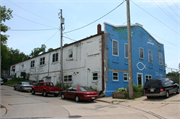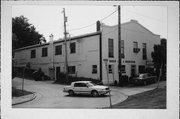Property Record
1110 - 1112 S ONEIDA ST
Architecture and History Inventory
| Historic Name: | Appleton Riding Club |
|---|---|
| Other Name: | BADGER LABS & ENGNRNG./ |
| Contributing: | |
| Reference Number: | 38884 |
| Location (Address): | 1110 - 1112 S ONEIDA ST |
|---|---|
| County: | Outagamie |
| City: | Appleton |
| Township/Village: | |
| Unincorporated Community: | |
| Town: | |
| Range: | |
| Direction: | |
| Section: | |
| Quarter Section: | |
| Quarter/Quarter Section: |
| Year Built: | 1925 |
|---|---|
| Additions: | |
| Survey Date: | 19912015 |
| Historic Use: | Agricultural - outbuilding |
| Architectural Style: | Commercial Vernacular |
| Structural System: | |
| Wall Material: | Concrete Block |
| Architect: | |
| Other Buildings On Site: | |
| Demolished?: | No |
| Demolished Date: |
| National/State Register Listing Name: | Not listed |
|---|---|
| National Register Listing Date: | |
| State Register Listing Date: |
| Additional Information: | 2015: This two-story, reinforced concrete block structure is topped with a gabled roof that is obscured by a parapet endwall. All original window openings along the building's entrance (west) elevation have been downsized and new windows installed. Side elevations are similar (both window downsizing and replacements) and also include a few overhead garage doors. This facility was built in 1925 to serve as an indoor riding ring for the Appleton Riding Club-notably the first indoor riding ring in the state of Wisconsin. The club was formally incorporated in 1925 by Appleton residents Edward Pfeil and K.S. Dickenson, as well as Ernst Mahler of Neenah with a capital stock of $15,000. The purpose of the club was to "breed, buy and sell, hire and board and train horses" and it also operated a riding academy. By no later than October of that same year, the subject building was completed; classes were held both day and night. Pfeil, who was born in Sturgeon Bay and moved to Appleton in 1920, was noted as the primary person to establish the club. The 1959 obituary of Pfeil cited that the club and the riding academy operated through 1948 and sale ad in 1958 noted that the prope1iy, which consisted of 28 acres, was available. The 1951 update to the city Sanborn map identifies the building as being used for sign printing. The structure, today, operates as the Freedom Center Food Pantry. Although Edward Pfeil is identified as the founder of the Appleton Riding Club and responsible for the establishment of the Appleton Riding Academy, no information was found to suggest potential eligibility under Criterion B: Significant Persons. Regarding Criterion A: History, the subject facility-reportedly the first in the State of Wisconsin--reflects a period of history during which time the leisure riding of horses in urban areas was popular. While the structure is indeed notable for that period of bygone history, the significant alterations to the structure outweigh its historical significance. |
|---|---|
| Bibliographic References: | “Appleton Riding Club Becomes Corporation,” Appleton Post-Crescent, 22 May 1925; Ad for “First Indoor Riding Ring in State,” Appleton Post-Crescent, 23 October 1925; “Hotel, Livery Man Dies,” Obituary for Edward Pfeil, Appleton Post-Crescent, 21 April 1959, A8; Sale ad for Appleton Riding Club Property, Appleton Post-Crescent, 6 October 1958. |
| Wisconsin Architecture and History Inventory, State Historic Preservation Office, Wisconsin Historical Society, Madison, Wisconsin |


